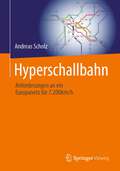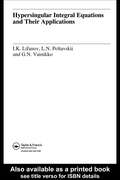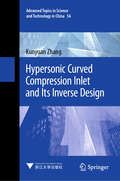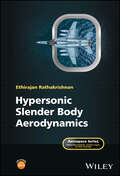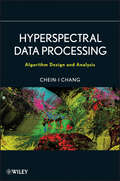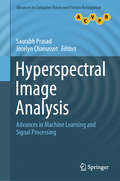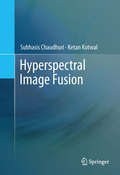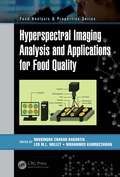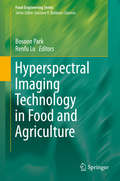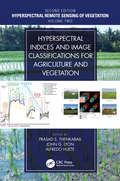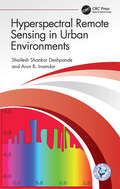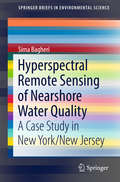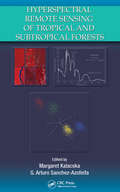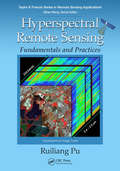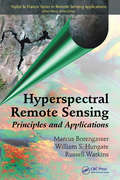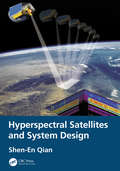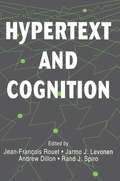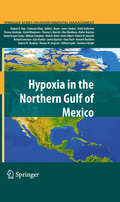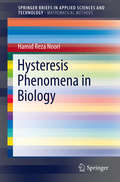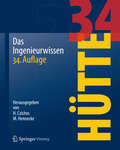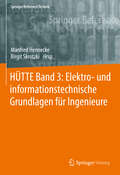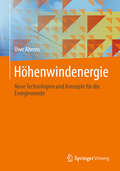- Table View
- List View
Hyperschallbahn: Anforderungen an ein Europanetz für 7.200km/h
by Andreas ScholzDas Buch beschreibt die Anforderungen an ein Europanetz der Hyperschallbahn auf der Basis der Vakuum-Magnetbahn-Technologie. Es veranschaulicht die vorhandenen und perspektivischen Marktpotenziale im kontinentalen und interkontinentalen Verkehr unter der Maßgabe, dass der Luftverkehr weitgehend durch das neue Verkehrssystem abgelöst wird. Das Buch leitet die Anforderungen an die wesentlichen Systemelemente und die Netzgestaltung ab, um die Marktpotenziale vollständig zu erschließen. Es beschreibt ein Basisnetz und ermittelt auf dieser Grundlage die Entwicklung der Erträge und Kosten sowie die Finanzierung des Systems in einer definierten Zeitlinie über einen gesamten Lebenszyklus. Ergänzend werden weitere breitgefächerte Nachfrage-Szenarien aufgezeigt und technisch-betriebswirtschaftlich bewertet. Das Buch beschreibt die Auswirkungen des Vakuum-Magnetbahn-Systems auf den Luftverkehr und zeigt abschließend Handlungsfelder für die Realisierung des neuen Verkehrssystems auf.
Hypersingular Integral Equations and Their Applications
by I.K. Lifanov L.N. Poltavskii MG.M. VainikkoA number of new methods for solving singular and hypersingular integral equations have emerged in recent years. This volume presents some of these new methods along with classical exact, approximate, and numerical methods. The authors explore the analysis of hypersingular integral equations based on the theory of pseudodifferential operators and co
Hypersonic Curved Compression Inlet and Its Inverse Design (Advanced Topics in Science and Technology in China #56)
by Kunyuan ZhangThis book presents systematic research results on curved shock wave-curved compression surface applied to the compression surface design of supersonic–hypersonic inlet, which is a brand new inlet design. The concept of supersonic inlet curved compression discussed originated from the author’s research at the Deutsches Zentrum fur Luft- und Raumfahrt (DLR SM-ES) in the early 1990s. This book introduces the research history, working characteristics, performance calculation and aerodynamic configuration design method of this compression mode in detail. It also describes method of estimating the minimum drag in inlet and drag reduction effect of curved compression and proposes a new index for evaluating unit area compression efficiency of the inlet. Further, it reviews the relevant recent research on curved compression. As such it is a valuable resource for students, researchers and scientists in the fields of hypersonic propulsion and aeronautics.
Hypersonic Missile Nonproliferation: Hindering the Spread of a New Class of Weapons
by Richard M. Moore Richard H. Speier George Nacouzi Carrie LeeThis report examines the implications of the proliferation of hypersonic missiles and possible measures to hinder it. This report first explores some of the potential strategic implications of the proliferation of hypersonic missile technology beyond the three major powers, the United States, Russia, and China. It then examines the process of such proliferation. And finally, it discusses possible means for hindering such proliferation.
Hypersonic Slender Body Aerodynamics (Aerospace Series)
by Ethirajan RathakrishnanOne-of-a-kind resource on theoretical and application aspects of hypersonic slender body aerodynamics with many didactic features included throughout Developed using class-tested course material, Hypersonic Slender Body Aerodynamics presents the theoretical and application aspects of the subject in a precise, concise, and student-friendly manner. The text includes a large number of worked examples, figures, diagrams, tables, and exercise problems. This book covers the subject material beginning from the definition of the slender body geometry through to the study of flow field around the body and the calculation of the aerodynamic and thermal loads acting on the body at speeds ranging from low to high (i.e., from incompressible to hypersonic speeds). The Mach number independence principle and approximate theories for caret wings are also covered, among many other key topics. This book is unique in its comprehensive coverage of the topic, enabling readers to find information in one place instead of scattered throughout proprietary wind tunnel test data, flight test data, government technical reports, scientific literature sources, and numerical methods. Some of the concepts explored in Hypersonic Slender Body Aerodynamics include: Wings of supersonic aircraft, covering sharp leading edges and ground and viscous effects, and pressure distribution on surfaces, covering transverse and longitudinal flow Hypersonic aerodynamics, covering atmospheric properties, hypersonic-flow characteristics, governing equations, and flow past a semi-wedge Application of slender-body theory, covering leading-edge heat transfer, sublimation, aerodynamic effects, nose bluntness, blast-wave theory, and thin shock layers Axisymmetric slender bodies, covering potential flow solutions and pressure distribution, and drag of slender bodies, covering shape factor and blunt after-body corrections Skillfully written with a clear and engaging writing style, Hypersonic Slender Body Aerodynamics is an essential learning resource on the subject for undergraduate and graduate students of aerospace engineering and practicing engineers working in aerospace research labs and industries. It is a perfect textbook for courses on slender body aerodynamics.
Hyperspectral Data Processing: Algorithm Design and Analysis
by Chein-I ChangHyperspectral Data Processing: Algorithm Design and Analysis is a culmination of the research conducted in the Remote Sensing Signal and Image Processing Laboratory (RSSIPL) at the University of Maryland, Baltimore County. Specifically, it treats hyperspectral image processing and hyperspectral signal processing as separate subjects in two different categories. Most materials covered in this book can be used in conjunction with the author's first book, Hyperspectral Imaging: Techniques for Spectral Detection and Classification, without much overlap. Many results in this book are either new or have not been explored, presented, or published in the public domain. These include various aspects of endmember extraction, unsupervised linear spectral mixture analysis, hyperspectral information compression, hyperspectral signal coding and characterization, as well as applications to conceal target detection, multispectral imaging, and magnetic resonance imaging. Hyperspectral Data Processing contains eight major sections: Part I: provides fundamentals of hyperspectral data processing Part II: offers various algorithm designs for endmember extraction Part III: derives theory for supervised linear spectral mixture analysis Part IV: designs unsupervised methods for hyperspectral image analysis Part V: explores new concepts on hyperspectral information compression Parts VI & VII: develops techniques for hyperspectral signal coding and characterization Part VIII: presents applications in multispectral imaging and magnetic resonance imaging Hyperspectral Data Processing compiles an algorithm compendium with MATLAB codes in an appendix to help readers implement many important algorithms developed in this book and write their own program codes without relying on software packages. Hyperspectral Data Processing is a valuable reference for those who have been involved with hyperspectral imaging and its techniques, as well those who are new to the subject.
Hyperspectral Image Analysis: Advances in Machine Learning and Signal Processing (Advances in Computer Vision and Pattern Recognition)
by Jocelyn Chanussot Saurabh PrasadThis book reviews the state of the art in algorithmic approaches addressing the practical challenges that arise with hyperspectral image analysis tasks, with a focus on emerging trends in machine learning and image processing/understanding. It presents advances in deep learning, multiple instance learning, sparse representation based learning, low-dimensional manifold models, anomalous change detection, target recognition, sensor fusion and super-resolution for robust multispectral and hyperspectral image understanding. It presents research from leading international experts who have made foundational contributions in these areas. The book covers a diverse array of applications of multispectral/hyperspectral imagery in the context of these algorithms, including remote sensing, face recognition and biomedicine. This book would be particularly beneficial to graduate students and researchers who are taking advanced courses in (or are working in) the areas of image analysis, machine learning and remote sensing with multi-channel optical imagery. Researchers and professionals in academia and industry working in areas such as electrical engineering, civil and environmental engineering, geosciences and biomedical image processing, who work with multi-channel optical data will find this book useful.
Hyperspectral Image Fusion
by Subhasis Chaudhuri Ketan KotwalHyperspectral Image Fusion is the first text dedicated to the fusion techniques for such a huge volume of data consisting of a very large number of images. This monograph brings out recent advances in the research in the area of visualization of hyperspectral data. It provides a set of pixel-based fusion techniques, each of which is based on a different framework and has its own advantages and disadvantages. The techniques are presented with complete details so that practitioners can easily implement them. It is also demonstrated how one can select only a few specific bands to speed up the process of fusion by exploiting spatial correlation within successive bands of the hyperspectral data. While the techniques for fusion of hyperspectral images are being developed, it is also important to establish a framework for objective assessment of such techniques. This monograph has a dedicated chapter describing various fusion performance measures that are applicable to hyperspectral image fusion. This monograph also presents a notion of consistency of a fusion technique which can be used to verify the suitability and applicability of a technique for fusion of a very large number of images. This book will be a highly useful resource to the students, researchers, academicians and practitioners in the specific area of hyperspectral image fusion, as well as generic image fusion.
Hyperspectral Imaging Analysis and Applications for Food Quality (Food Analysis & Properties)
by Leo M.L. Nollet N. C. Basantia Mohammed KamruzzamanIn processing food, hyperspectral imaging, combined with intelligent software, enables digital sorters (or optical sorters) to identify and remove defects and foreign material that are invisible to traditional camera and laser sorters. Hyperspectral Imaging Analysis and Applications for Food Quality explores the theoretical and practical issues associated with the development, analysis, and application of essential image processing algorithms in order to exploit hyperspectral imaging for food quality evaluations. It outlines strategies and essential image processing routines that are necessary for making the appropriate decision during detection, classification, identification, quantification, and/or prediction processes. Features Covers practical issues associated with the development, analysis, and application of essential image processing for food quality applications Surveys the breadth of different image processing approaches adopted over the years in attempting to implement hyperspectral imaging for food quality monitoring Explains the working principles of hyperspectral systems as well as the basic concept and structure of hyperspectral data Describes the different approaches used during image acquisition, data collection, and visualization The book is divided into three sections. Section I discusses the fundamentals of Imaging Systems: How can hyperspectral image cube acquisition be optimized? Also, two chapters deal with image segmentation, data extraction, and treatment. Seven chapters comprise Section II, which deals with Chemometrics. One explains the fundamentals of multivariate analysis and techniques while in six other chapters the reader will find information on and applications of a number of chemometric techniques: principal component analysis, partial least squares analysis, linear discriminant model, support vector machines, decision trees, and artificial neural networks. In the last section, Applications, numerous examples are given of applications of hyperspectral imaging systems in fish, meat, fruits, vegetables, medicinal herbs, dairy products, beverages, and food additives.
Hyperspectral Imaging Technology in Food and Agriculture
by Bosoon Park Renfu LuHyperspectral imaging or imaging spectroscopy is a novel technology for acquiring and analysing an image of a real scene by computers and other devices in order to obtain quantitative information for quality evaluation and process control. Image processing and analysis is the core technique in computer vision. With the continuous development in hardware and software for image processing and analysis, the application of hyperspectral imaging has been extended to the safety and quality evaluation of meat and produce. Especially in recent years, hyperspectral imaging has attracted much research and development attention, as a result rapid scientific and technological advances have increasingly taken place in food and agriculture, especially on safety and quality inspection, classification and evaluation of a wide range of food products, illustrating the great advantages of using the technology for objective, rapid, non-destructive and automated safety inspection as well as quality control. Therefore, as the first reference book in the area, Hyperspectral Imaging Technology in Food and Agriculture focuses on these recent advances. The book is divided into three parts, which begins with an outline of the fundamentals of the technology, followed by full covering of the application in the most researched areas of meats, fruits, vegetables, grains and other foods, which mostly covers food safety and quality as well as remote sensing applicable for crop production. Hyperspectral Imaging Technology in Food and Agriculture is written by international peers who have both academic and professional credentials, with each chapter addressing in detail one aspect of the relevant technology, thus highlighting the truly international nature of the work. Therefore the book should provide the engineer and technologist working in research, development, and operations in the food and agricultural industry with critical, comprehensive and readily accessible information on the art and science of hyperspectral imaging technology. It should also serve as an essential reference source to undergraduate and postgraduate students and researchers in universities and research institutions.
Hyperspectral Indices and Image Classifications for Agriculture and Vegetation (Hyperspectral Remote Sensing of Vegetation, Second Edition)
by Prasad S. Thenkabail, John G. Lyon and Alfredo HueteWritten by leading global experts, including pioneers in the field, the four-volume set on Hyperspectral Remote Sensing of Vegetation, Second Edition, reviews existing state-of- the-art knowledge, highlights advances made in different areas, and provides guidance for the appropriate use of hyperspectral data in the study and management of agricultural crops and natural vegetation.Volume II, Hyperspectral Indices and Image Classifications for Agriculture and Vegetation evaluates the performance of hyperspectral narrowband or imaging spectroscopy data with specific emphasis on the uses and applications of hyperspectral narrowband vegetation indices in characterizing, modeling, mapping, and monitoring agricultural crops and vegetation. This volume presents and discusses topics such as the non-invasive quantification of foliar pigments, leaf nitrogen concentration of cereal crop, the estimation of nitrogen content in crops and pastures, and forest leaf chlorophyll content, among others. The concluding chapter provides readers with useful guidance on the highlights and essence of Volume II through the editors’ perspective.Key Features of Volume II: Provides the fundamentals of hyperspectral narrowband vegetation indices and hyperspectral derivative vegetation indices and their applications in agriculture and vegetation studies. Discusses the latest advances in hyperspectral image classification methods and their applications. Explains the massively big hyperspectral sensing data processing on cloud computing architectures. Highlights the state-of-the-art methods in the field of hyperspectral narrowband vegetation indices for monitoring agriculture, vegetation, and their properties such as plant water content, nitrogen, chlorophyll, and others at leaf, canopy, field, and landscape scales. Includes best global expertise on hyperspectral remote sensing of agriculture, crop water use, plant species detection, crop productivity and water productivity mapping, and modeling.
Hyperspectral Remote Sensing in Urban Environments
by Shailesh Shankar Deshpande Arun B. InamdarThis book is intended to provide a detailed perspective on techniques and challenges in detecting urban materials using hyperspectral data including a systematic perspective on the spectral properties of the materials and methods. It adopts a process chain approach in describing the topic and explains image processing steps from reflectance calibration to final insights. The objective of the book is to provide in-depth information on hyperspectral remote sensing of urban materials covering global case studies as applicable. Features: Covers the complete processing chain of hyperspectral data specifically in urban environments; Gives more information about the mapping and classification of urban scenes; Includes information from basic imaging spectroscopy to advanced methods such as deep learning for imaging spectroscopy; Reviews detailed spectral characteristics of urban materials commonly found in world cities; Discusses advanced supervised methods such as deep learning with a due focus on hyperspectral data analysis. This book is aimed at professionals and graduate students in Hyperspectral Imaging, Urban Remote Sensing, and Hyperspectral Image Processing.
Hyperspectral Remote Sensing of Nearshore Water Quality
by Sima BagheriThis book provides details on of the utility of hyperspectral remote sensing - NASA/AVIRIS in nearshore water quality issues of NY/NJ. It demonstrates the use of bio optical modeling and retrieval techniques to derive the concentrations of important water quality parameters (chlorophyll, color dissolved organic matter and suspended sediments) in the study area. The case study focuses on the nearshore waters of NY/NJ considered as a valued ecological, economic and recreational resource within the New York metropolitan area. During field campaigns (1998-2001) measurements were made to establish hydrological optical properties of the NY/NJ nearshore waters with concurrent NASA/AVIRIS overflights. The field measurements included: 1) concurrent above and below surface spectral reflectance; 2) shipboard sampling for determination of inherent optical properties (IOP); and 3) concentrations of optically important water quality parameters. Understanding the relationship between reflectance, absorption and scattering is essential for developing the analytical algorithm necessary to use remote sensing as a monitoring /management tool in the nearshore environment.
Hyperspectral Remote Sensing of Tropical and Sub-Tropical Forests
by Margaret Kalacska G. Arturo Sanchez-AzofeifaWhile frequently used in temperate environments, hyperspectral sensors and data are still a novelty in the tropics. Exploring the potential of hyperspectral remote sensing for assessing ecosystem characteristics, Hyperspectral Remote Sensing of Tropical and Sub-Tropical Forests focuses on the complex and unique set of challenges involved in using t
Hyperspectral Remote Sensing: Fundamentals and Practices (Remote Sensing Applications Series)
by Ruiliang PuAdvanced imaging spectral technology and hyperspectral analysis techniques for multiple applications are the key features of the book. This book will present in one volume complete solutions from concepts, fundamentals, and methods of acquisition of hyperspectral data to analyses and applications of the data in a very coherent manner. It will help readers to fully understand basic theories of HRS, how to utilize various field spectrometers and bioinstruments, the importance of radiometric correction and atmospheric correction, the use of analysis, tools and software, and determine what to do with HRS technology and data.
Hyperspectral Remote Sensing: Principles and Applications (Remote Sensing Applications Series)
by Marcus Borengasser William S. Hungate Russell WatkinsLand management issues, such as mapping tree species, recognizing invasive plants, and identifying key geologic features, require an understanding of complex technical issues before the best decisions can be made. Hyperspectral remote sensing is one the technologies that can help with reliable detection and identification. Presenting the fundamenta
Hyperspectral Satellites and System Design
by Shen-En QianHyperspectral Satellites and System Design is the first book on this subject. It provides a systematic analysis and detailed design of the entire development process of hyperspectral satellites. Derived from the author’s 25-year firsthand experience as a technical lead of space missions at the Canadian Space Agency, the book offers engineers, scientists, and decision-makers detailed knowledge and guidelines on hyperspectral satellite system design, trade-offs, performance modeling and simulation, optimization from component to system level, subsystem design, and implementation strategies. This information will help reduce the risk, shorten the development period, and lower the cost of hyperspectral satellite missions. This book is a must-have reference for professionals in developing hyperspectral satellites and data applications. It is also an excellent introductory book for early practitioners and students who want to learn more about hyperspectral satellites and their applications.
Hypertext and Cognition
by Jean-François Rouet Rand J. Spiro Andrew Dillon Jarmo J. LevonenThe recent evolution of western societies has been characterized by an increasing emphasis on information and communication. As the amount of available information increases, however, the user -- worker, student, citizen -- faces a new problem: selecting and accessing relevant information. More than ever it is crucial to find efficient ways for users to interact with information systems in a way that prevents them from being overwhelmed or simply missing their targets. As a result, hypertext systems have been developed as a means of facilitating the interactions between readers and text. In hypertext, information is organized as a network in which nodes are text chunks (e.g., lists of items, paragraphs, pages) and links are relationships between the nodes (e.g., semantic associations, expansions, definitions, examples -- virtually any kind of relation that can be imagined between two text passages). Unfortunately, the many ways in which these hypertext interfaces can be designed has caused a complexity that extends far beyond the processing abilities of regular users. Therefore, it has become widely recognized that a more rational approach based on a thorough analysis of information users' needs, capacities, capabilities, and skills is needed. This volume seeks to meet that need. From a user-centered perspective -- between systems and users -- this volume presents theoretical and empirical research on the cognitive processes involved in using hypertext. In so doing, it illustrates three main approaches to the design of hypertext systems: *cognitive, which examines how users process multilayered hypertext structures; *ergonomical, which explores how users interact with the design characteristics of hardware and software; and *educational, which studies the learning objectives, frequency and duration of hypertext sessions, type of reading activity, and the user's learning characteristics. This volume also tries to provide answers for the questions that have plagued hypertext research: *What is hypertext good for? *Who is hypertext good for? *If it is useful for learning and instruction, then what type? *What particular cognitive skills are needed to interact successfully with a hypertext system? Anyone interested in the fields of computer science, linguistics, psychology, education, and graphic design will find this volume intriguing, informative, and a definitive starting point for future research in the field of hypertext.
Hypoxia in the Northern Gulf of Mexico
by Mark David James Sanders Clifford S. Snyder Hans Paerl William Crumpton Denis Gilbert Alan Blumberg Daniel J. Conley Andrew N. Sharpley Thomas Bianchi Thomas W. Simpson Thomas Armitage Donelson Wright Holly Stallworth Catherine L. Kling Virginia H. Dale David Wangsness Kenneth Reckhow Kyle Mankin Richard Lowrance Robert W. Howarth Judith L. Meyer Walter Boynton James OpaluchThe goal of the book is to examine scientific advances since 2000 that may have increased understanding and options in three general areas related to hypoxia: Characterization the Cause(s) of Hypoxia. The physical, biological and chemical processes that affect the development, persistence and extent of hypoxia in the northern Gulf of Mexico. Characterization of Nutrient Fate, Transport and Sources. Nutrient loadings, fate, transport and sources in the Mississippi River that impact Gulf Hypoxia. Scientific Basis for Goals and Management Options. The scientific basis for, and recommended revisions to, the goals proposed in the Action Plan; and the scientific basis for the efficacy of recommended management actions to reduce nutrient flux from point and nonpoint sources. In addressing the state of the science, the book focuses on the strengths and limitations of the science in managing the Gulf hypoxia problem, including available data, models and model results and uncertainty. It includes work from the following authors: C. Kling, Iowa State University, Ames, IA, USA; J.L. Meyer, University of Georgia, Athens, GA, USA; J. Sanders, Skidaway Institute of Oceanography, Savannah, GA, USA; H. Stallworth, Environmental Protection Agency, Washington D.C., USA; T. Armitage, Environmental Protection Agency,Washington, D.C., USA; D. Wangsness, U.S. Geological Survey, Atlanta, GA, USA; T.S. Bianchi, Texas A&M University, College Station, TX, USA; A. Blumberg, Stevens Institute of Technology, Hoboken, NJ, USA; W. Boynton, University of Maryland, MD, USA; D.J. Conley, Lund University, Lund, Sweden; W. Crumpton, Iowa State University, Ames, IA, USA; M.B. David, University of Illinois, Urbana, IL, USA; D. Gilbert, Maurice-Lamontagne Institute, Mont-Joli, Quebec, Canada; R.W. Howarth, Cornell University, Ithaca, NY, USA; R. Lowrance, Agricultural Research Service, USDA, Tifton, GA, USA; K. Mankin, Kansas State University, Manhattan, KS, USA; J. Opaluch, University of Rhode Island, Kingston, RI, USA; H. Paerl, University of North Carolina, Chapel Hill, Morehead City, NC, USA; K. Reckhow, Duke University, Durham, NC, USA; A.N. Sharpley, University of Arkansas, Fayetteville, AR, USA; T.W. Simpson, University of Maryland, College Park, MD, USA; C. Snyder, International Plant Nutrition Institute,USA; Conway, AR; D. Wright, College of William and Mary, Gloucester Point, VA, USA.
Hysteresis Phenomena in Biology
by Hamid Reza NooriThe occurrence of hysteresis phenomena has been traditionally associated with mechanical and magnetic properties of materials. However, recent studies on the dynamics of biological processes suggest switch-like behavior that could be described by mathematical models of hysteresis. This book presents the milestones and perspectives of biological hysteresis and provides a comprehensive and application-oriented introduction to this subject. The target audience primarily comprises researchers but the book may also be beneficial for graduate students.
HÜTTE - Das Ingenieurwissen
by Horst Czichos Akademischer Verein Hütte e.V. Manfred HenneckeDas Werk präsentiert die mathematisch-naturwissenschaftlichen, ökonomisch-rechtlichen sowie technologischen Grundlagen des Ingenieurwissens - alles in einem Band. Für die Neuauflage wurden sämtliche Inhalte fachlich ergänzt, insbesondere die Abschnitte zu Makromolekülen, Umweltverträglichkeit, Recycling, Festigkeitslehre, Mikrosensorik, binäre Steuerungstechnik, Software-Engineering, Kommunikationstechnik, Mensch-Maschine-Interaktion sowie Normung, Recht und Patente. Neu hinzugekommen sind die Themen Management, Qualität und Personal.
HÜTTE Band 1: Mathematisch-naturwissenschaftliche und allgemeine Grundlagen für Ingenieure (Springer Reference Technik)
by Manfred Hennecke Birgit SkrotzkiDas Standardwerk HÜTTE erscheint in der 35., aktualisierten Auflage in der Reihe Springer Reference Technik. Diese Reihe bietet allen Ingenieurinnen und Ingenieuren – ob im Studium oder in allen Formen des Berufslebens – zielführendes Fachwissen in aktueller, kompakter und verständlicher Form. Die HÜTTE enthält in drei Bänden die Grundlagen des Ingenieurwissens sowie ökonomisch-gesellschaftliche Kapitel, die das Ingenieurwissen ergänzen. Band 1 umfasst Mathematisch-naturwissenschaftliche und allgemeine Grundlagen: Mathematik Physik Chemie Recht Patente Technik- und RisikokommunikationBand 2 Grundlagen des Maschinenbaus und ergänzende FächerBand 3 Elektro- und informationstechnische Grundlagen
HÜTTE Band 2: Grundlagen des Maschinenbaus und ergänzende Fächer für Ingenieure (Springer Reference Technik)
by Manfred Hennecke Birgit SkrotzkiDas Standardwerk HÜTTE erscheint in der 35., aktualisierten Auflage in der Reihe Springer Reference Technik. Diese Reihe bietet allen Ingenieurinnen und Ingenieuren – ob im Studium oder in allen Formen des Berufslebens – zielführendes Fachwissen in aktueller, kompakter und verständlicher Form. Die HÜTTE enthält in drei Bänden die Grundlagen des Ingenieurwissens sowie ökonomisch-gesellschaftliche Kapitel, die das Ingenieurwissen ergänzen. Band 2 umfasst Grundlagen des Maschinenbaus und ergänzende Fächer: Werkstoffe Technische Mechanik Technische Thermodynamik Entwicklung Konstruktion Produktion Logistik Betriebswirtschaft Management NormungBand 1 Mathematisch-naturwissenschaftliche und allgemeine GrundlagenBand 3 Elektro- und informationstechnische Grundlagen
HÜTTE Band 3: Elektro- und informationstechnische Grundlagen für Ingenieure (Springer Reference Technik)
by Manfred Hennecke Birgit SkrotzkiDas Standardwerk HÜTTE erscheint in der 35., aktualisierten Auflage in der Reihe Springer Reference Technik. Diese Reihe bietet allen Ingenieurinnen und Ingenieuren – ob im Studium oder in allen Formen des Berufslebens – zielführendes Fachwissen in aktueller, kompakter und verständlicher Form. Die HÜTTE enthält in drei Bänden die Grundlagen des Ingenieurwissens sowie ökonomisch-gesellschaftliche Kapitel, die das Ingenieurwissen ergänzen. Band 3 umfasst Elektro- und informationstechnische Grundlagen: Elektrotechnik Messtechnik Regelungs- und Steuerungstechnik Informatik InformationsmanagementBand 1 Mathematisch-naturwissenschaftliche und allgemeine GrundlagenBand 2 Grundlagen des Maschinenbaus und ergänzende Fächer
Höhenwindenergie: Neue Technologien und Konzepte für die Energiewende
by Uwe AhrensDieses Buch stellt wesentliche Technologien zur Nutzung der Windenergie vor und zeigt Lösungsmöglichkeiten auf, wie eine rentable Energieversorgung umgesetzt werden kann. Im Fokus steht die Höhenwindnutzung. Die Windenergie aus der Luft ist eine der vielversprechendsten Technologien, um die Energiewende wirtschaftlich zu gestalten. Präsentiert werden die JoJo-Technologien, die Fliegende Generator Technologien und weitere Konzepte zur Höhenwindenergieernte. Darüber hinaus bietet das Buch Informationen zum Materialverbrauch, zur Recyclingfähigkeit, zu Verschattungseffekten, zur Skalierbarkeit, zur Grundlastfähigkeit, zum Klimafußabdruck (GWP), zur Landschaftsbildbeeinflussung, zur Geräuschbelastung und zur E-Mobilität.Das Buch erläutert, wie wir in Zukunft unseren gesamten Energiebedarf (Strom, Mobilität und Wärme) ohne fossile Brennstoffe decken können, ohne die Wettbewerbsfähigkeit unserer Wirtschaft zu gefährden. Ein Wegweiser für Ökonomen, Umweltschützer und Politiker.
